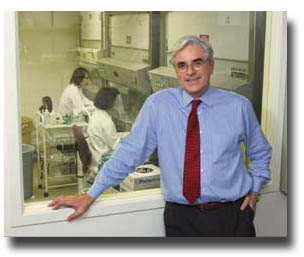New discovery about the mechanism of action and development of cancer cells
Researchers working at the Medical School at the University of California, San Diego, USA have discovered a "stress response" mechanism used by normal cells in response to etching requirements. harsh, harsh, created by cancer cells, by transmitting similar stress signals to benign cells around it, activating an inflammatory reaction, helping the tumor grow.

Dr. Maurizio Zanetti, professor of medicine
The findings were published in the Proceedings of the National Academy of Sciences magazine, April 4, 2011, by Dr. Maurizio Zanetti, professor of medicine, and director of the Immunology Laboratory, of Moores Cancer Center, at UC University, San Diego, USA, and colleagues.
The endoplasmic reticulum (ER) acts as a protein factory located inside the cells. The proliferation of physiological needs or pathogenic conditions can sometimes cause the twisting of proteins to be biased and accumulate in ER endothelial tissues. Cells often respond with an ER stress response, through which the cells try to reset the ER balance to normal levels.
For benign cells, the response to ER stress is transient. However, for cancer cells, the stress response ER is life, helping the tumor grow. Because cancer cells exist in harsh living environments, it is always difficult (our bodies always try to destroy cancer cells, besides regular cancer cells hypoxia and lack of nutrients), so cancer cells have produced an ongoing ER stress response, to help them not only exist, but also thrive. .
According to Dr. Maurizio Zanetti and colleagues, tumor cells created " stress ER can transfer ." Specifically, they cause benign cells to produce a similar stress response, most notably affecting both nearby macrophages, a type of white blood cell that takes care of the work. The body's immune system is recognizing and eliminating pathogens and cell debris.
Recently, several laboratories, including some at UC University, San Diego, USA, have emphasized the important role of inflammatory response, in promoting the development of cancer. A consequence of "transferable ER stress ," which the destination to " receive " is macrophages, which is an important source of inflammatory response, plays a role in creating an ideal environment. for cancer growth.
" It is very obvious that when macrophages enter the tumor microenvironment, they will lose the ability to support the immune system in removing tumors, but they can actually play a role. The role of the immune system in proactively suppressing cancer blocks , "said Zanetti. " We believe that" ER stress can be transferred, "which may be an important signal, derived from an initial tumor, to promote" brainwashing "of macrophages in the lips. The microscopic field of the tumor It may be the first event in a series of sequential effects aimed at exposing these tumor macrophages . "
If so, then " transferable ER stress ," may represent a unified mechanism to explain at least some of the first interactions between tumors and the immune system. " We have noted the first evidence of this phenomenon very detailed and clear ," Zanetti added, "that ER stress can be transferred ," also uncovering a new target, potential for modulation. Drugs combined with specific therapies to affect tumors.
" Our findings suggest that the development of targeted therapies against" response to ER stress "by tumors can provide twice the therapeutic effect, " says Zanetti. "This therapy is not only intended to weaken the internal ability of tumors in micro-environments, but at the same time, will hinder the ability of cancer cells, want to disable the anti-cancer immune response. , making it easier for our immune system to fight cancer tumors . "
The co-authors of this study also include: Navin Mahadevan and Jeffrey R. Rodvold, from the Biomedical Sciences Program and the Immunology Laboratory, at Moores Cancer Center, at UC University, San Diego, USA; Homero Sepulveda, from BD Biosciences, San Diego, USA; Steven Rossi, from Cancer Symptom Control Program, Department of Pediatrics, UC University, San Diego, USA; and Angela F. Drew, from the Department of Cancer and Cell Biology, University of Cincinnati, USA.
Funding for this study, in part, comes from the sponsorship of the University of UC, San Diego; Training program for medical scientists, University of UC, San Diego and National Research Institute on drug abuse.
- New discovery of metastatic mechanism of cancer cells
- Singapore found a mechanism to make cancer cells 'suicide'
- Detection of the p53 gene inhibits the growth of cancer cells
- Detecting a protein that kills cancer cells
- Mechanism of enzyme action helps to control cancer
- Discovered the attack mechanism of cancer cells
- Italian scientists found metastasis in breast cancer
- Video: See for yourself the cancer cells spread throughout the body
- Find a mechanism that makes cancer 'avoid' chemotherapy
- There are drugs that slow the progression of cancer cells
- Image of cancer cells under a microscope
- Causes of DNA fracture in cancer cells
 Green tea cleans teeth better than mouthwash?
Green tea cleans teeth better than mouthwash? Death kiss: This is why you should not let anyone kiss your baby's lips
Death kiss: This is why you should not let anyone kiss your baby's lips What is salmonellosis?
What is salmonellosis? Caution should be exercised when using aloe vera through eating and drinking
Caution should be exercised when using aloe vera through eating and drinking